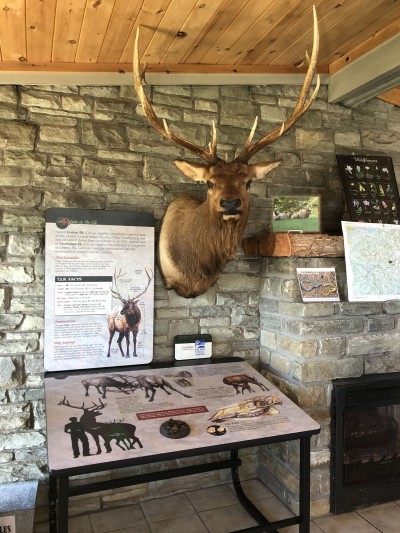Elk display Waterrock Knob.jpg
 A new elk display at Waterrock Knob Visitor Center on the Blue Ridge Parkway.
A new elk display at Waterrock Knob Visitor Center on the Blue Ridge Parkway. Did you know that elk can run up to 45 miles per hour? That black bear cubs stay with their mother for 18 months learning to hunt and survive? That, at 6,293 feet, Waterrock Knob is the highest peak in the Plott Balsam Mountains?
Thanks to donor support, new exhibits are now sharing these fascinating facts and more insights with people who visit Waterrock Knob Visitor Center at milepost 451.2, near Sylva, North Carolina. The attractive panels and displays installed in September are replacements for time-worn and outdated exhibits. For example, makeshift poster board displays have been replaced with new permanent panels that tell how elk have returned to the Parkway.
A 12-foot mural illustrates a multi-seasonal peek at some of the unique flora and fauna of this high elevation environment, as well as the striking geological features of the brightly colored rock formations found on cliffs near the visitor center. Another panel tells the Cherokee story of “How the World was Made,” which describes the buzzard creating the peaks and valleys with its wings, in both Cherokee syllabary and English. An interactive element encourages visitors to turn a handle to see a magnified version of a balsam woolly adelgid, the insect responsible for the death of many trees visible from a large window.
The designs were a collaboration between National Park Service interpretive staff and David Williams of Wingin’ It Works, which specializes in exhibits, murals, and scientific illustration. Joe Bistany of BistanyWorks provided fabrication and technical assistance.
“On-site meetings with rangers and visitor center staff who experience Waterrock Knob throughout the year allowed me to get a better understanding of the beauty, diversity and often harsh reality of this high elevation habitat,” Williams said. “Multiple hikes, photo shoots and careful observation gave me the needed reference to pass along some of the fascinating information that's proudly shared by the people who love this unique stopover.”
To enjoy the displays before the visitor center closes for the season, stop by between 10 a.m. and 5 p.m., each day through November 14.